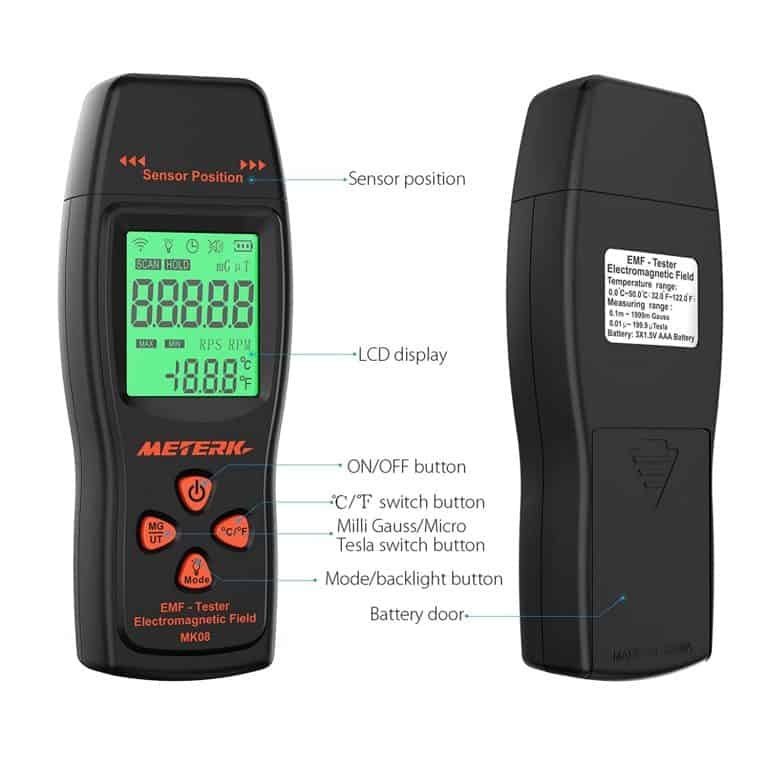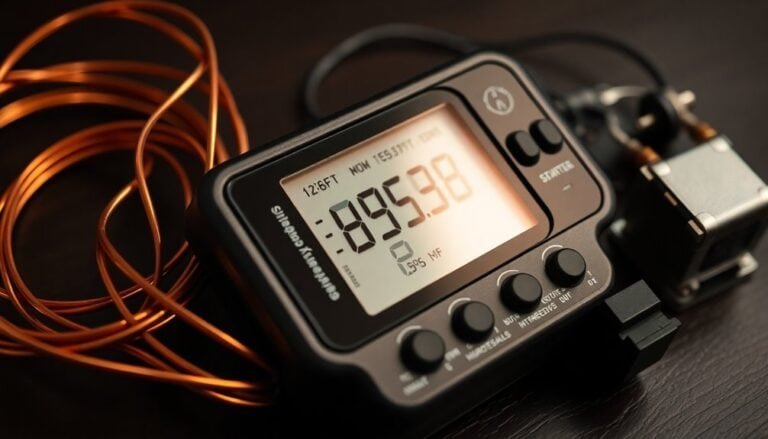Measuring Bluetooth and Wireless Device EMF
To measure EMF from Bluetooth and wireless devices, use high-frequency EMF meters, which display power density in mW/m² or electric field intensity in V/m. Bluetooth typically emits lower EMF, under 2 µW/cm², compared to Wi-Fi which can reach up to 17 µW/cm².
Selection of meters should consider features like triaxial probes for comprehensive assessments. Understanding these measurements is crucial for evaluating potential exposure levels and associated health implications, with ongoing research and safety guidelines offering further insights.
Disclaimer: As an affiliate, I may collect a share of sales from the links on this page.
Understanding Bluetooth EMF
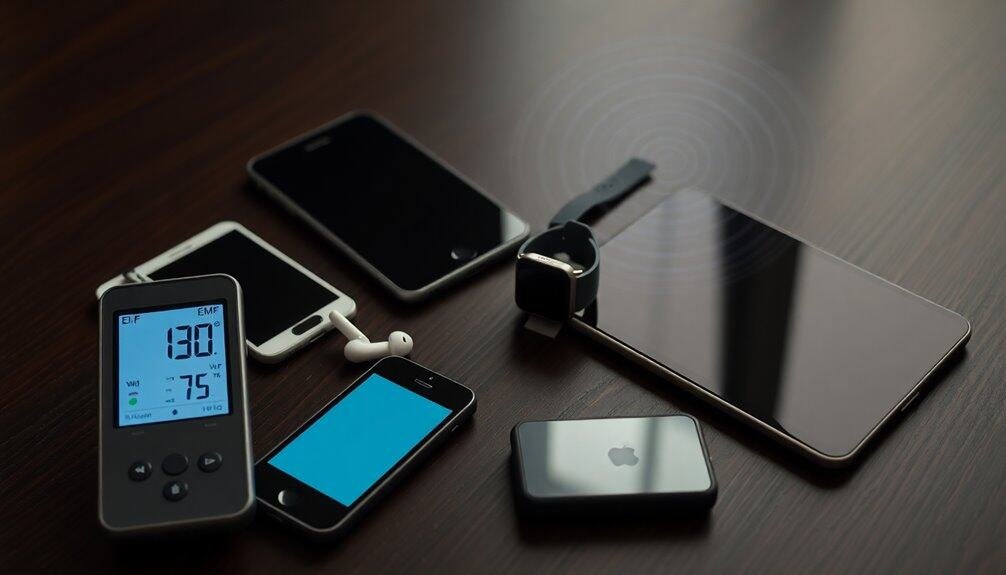
Understanding Bluetooth EMF
Bluetooth electromagnetic fields (EMF) operate within the 2.400–2.4835 GHz frequency range, which falls in the Industrial, Scientific, and Medical (ISM) band.
Typical Bluetooth devices transmit at 2.5 mW, considerably lower than cell phone output. Class 3 devices generally emit 1 mW, with outdoor ranges up to 10 meters.
Bluetooth employs frequency hopping, changing channels up to 1600 times per second, ensuring secure communication.
International guidelines establish exposure limits, and extensive research shows no adverse health effects at these levels. However, some scientists express concerns about potential health risks from Bluetooth EMF exposure, highlighting the need for further investigation.
Consequently, Bluetooth EMF poses minimal risk compared to other wireless devices, especially cell phones.
EMF Measurement Tools and Techniques
Various tools and techniques are essential for accurately measuring electromagnetic fields (EMF) emitted by devices like Bluetooth and Wi-Fi. High-frequency EMF meters cover frequencies from a few MHz to several GHz, measuring power density in mW/m² or electric field intensity in V/m. EMF meter selection criteria can help users avoid overpaying while ensuring they have the right features for their needs. Additionally, it’s important to select meters designed to measure high-frequency EMF as these devices are specifically tailored to capture the unique emissions from wireless technologies.
Gauss meters detect magnetic fields while handheld meters measure both electric and magnetic fields. Triaxial probes provide three-dimensional readings. Spot measurements focus on specific points, while personal monitoring tracks individual exposure. Microenvironmental and area monitoring assess various settings, and spectral analysis identifies EMF sources. These methods guarantee extensive EMF assessments across diverse environments.
Comparing Bluetooth and Wi-Fi EMF
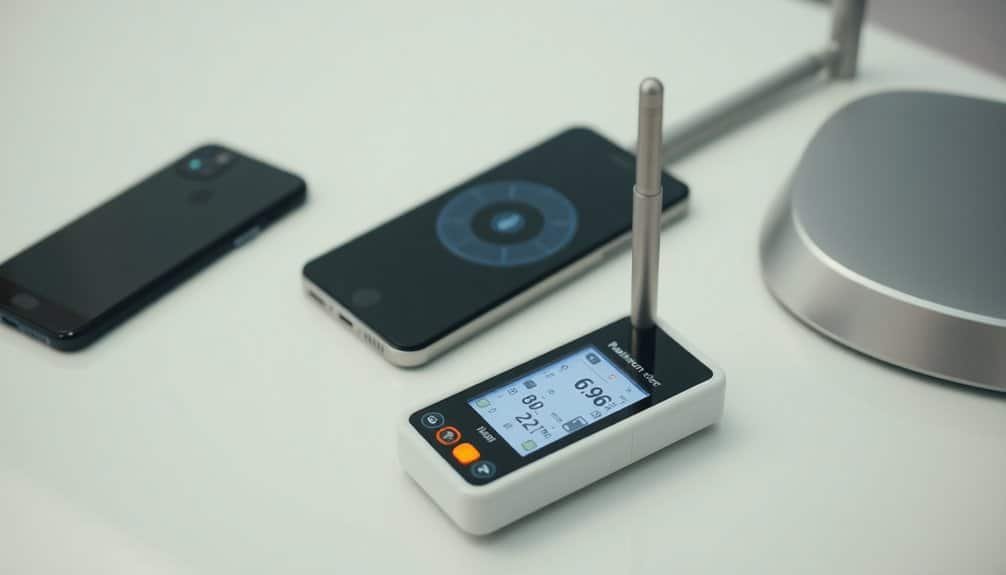
When you compare Bluetooth and Wi-Fi EMF emissions, you’ll notice distinct differences that impact both your devices and your environment. Bluetooth operates at a lower frequency, around 2.4 GHz, resulting in lower EMF emissions, typically less than 2 uW/cm². In contrast, Wi-Fi, using both 2.4 GHz and 5 GHz frequencies, emits between 4 and 17 uW/cm² during data transfers. Bluetooth consumes less power, while Wi-Fi is more powerful, making it suitable for larger data. Additionally, devices like smartphones emit more EMF on Wi-Fi compared to Bluetooth, highlighting the varying emission levels between these technologies. Notably, Bluetooth’s low power consumption makes it ideal for low-power applications, particularly in IoT settings where battery life is crucial. Continuous exposure to EMF radiation may lead to health risks, emphasizing the importance of monitoring both Bluetooth and Wi-Fi usage.
Health Concerns and Safety Guidelines
The discourse surrounding EMF exposure from wireless devices, including Bluetooth and Wi-Fi, raises important health considerations.
Research indicates inconclusive links between EMF exposure and cancer risks. Some studies suggest genetic damage, including DNA strand breaks. Neurological disorders could be associated with EMF, impacting learning and memory.
While safety standards exist for Bluetooth, emphasizing low power output, precautionary principles emerge due to unknown risks. The WHO states no evidence supports adverse health effects from low-level exposure. Continuous exposure to EMF radiation can lead to health issues, prompting families to seek protective measures.
Public awareness and future research are essential to understand the long-term effects of EMF, especially on vulnerable populations like children and pregnant individuals.
Devices for EMF Measurement
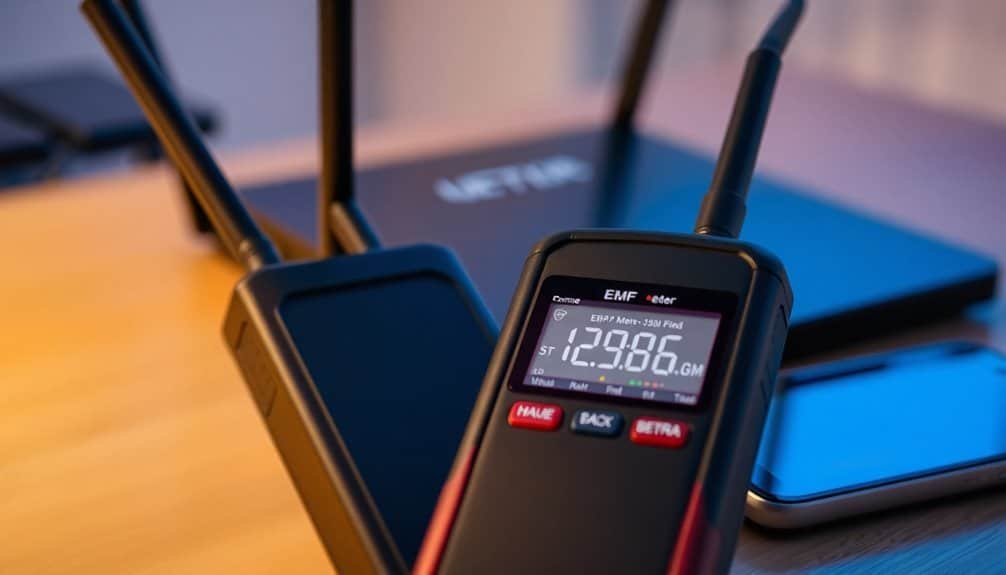
Electromagnetic field (EMF) meters serve as essential tools for detecting and measuring radiation from various sources, including Bluetooth and Wi-Fi devices.
You can choose between single-axis and tri-axis meters; the latter measures all three axes simultaneously, providing thorough data.
Features vary: low-frequency meters evaluate power line emissions, while high-frequency meters focus on wireless signals.
Devices like the PCE 3-in-1 meter gauge electric, magnetic, and radio frequency fields.
For industrial safety and telecommunications, accurate models like the Narda STS offer precision and speed.
Calibration guarantees compliance with safety standards, making these meters indispensable for evaluating electromagnetic exposure in various environments.
Future Trends in EMF Research
As researchers push the boundaries of electromagnetic field (EMF) understanding, several future trends are emerging in this field.
Advances in computational electromagnetics enable sophisticated simulations and field optimization, promoting safer device operations. International collaboration boosts knowledge exchange, focusing on practical applications in IoT environments.
Quantum technologies offer unprecedented sensitivity, enhancing EMF detection while integrating with AI for real-time data analysis. High-magnetic-field science practices inform exposure assessment standards.
Emerging materials, such as altermagnets and superconductors, aim to minimize unwanted EMF emissions. Together, these trends promise to advance EMF research and improve wireless device safety and efficiency greatly.
Frequently Asked Questions
Are Bluetooth-Emitting Devices Safe for Children to Use?
You should be cautious about Bluetooth devices for kids. While studies suggest they’re generally safe, limit their use to reduce exposure. Encourage wired alternatives and monitor usage to keep your child’s health a priority.
How Can I Reduce My Bluetooth EMF Exposure?
Sure, you could live in a tin can to avoid Bluetooth EMF exposure, but why not just use wired headphones? Limiting device time and keeping gadgets at a distance work wonders for your health, too!
Do Bluetooth Devices Interfere With Other Electronics?
Yes, Bluetooth devices can interfere with other electronics, especially those operating on similar frequencies. To minimize interference, keep devices spaced apart and opt for equipment designed to handle electromagnetic compatibility more effectively.
What Is the Difference Between Bluetooth and NFC EMF Emissions?
Bluetooth emits continuous radiofrequency radiation, while NFC generates a magnetic field only during use. You’ll notice Bluetooth’s wider range and higher power requirements, contrasting with NFC’s short-range efficiency and lower energy consumption for specific tasks.
Can Bluetooth EMF Affect Sleep Quality?
Yes, Bluetooth EMF can affect your sleep quality. While it typically emits lower power levels, prolonged exposure might disrupt your sleep patterns and melatonin production, leading to potential sleep disturbances and increased daytime sleepiness.
Conclusion
Understanding Bluetooth and wireless device EMF is crucial for making informed choices. Using the right measurement tools helps you effectively compare EMF levels. Ongoing health impact research highlights the need to follow safety guidelines. As technology progresses, awareness of EMF exposure will increase, promoting improved practices and innovations. Staying informed ensures safe device use while enjoying connectivity benefits.


